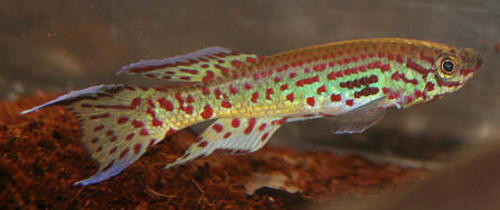Akwen

Akwen. Photo courtesy Peter Venstermans
|
Codes
|
BLLMC 05 / 2 | ||||
|
Geography
|
Akwen is situated on the main Eyomojok to Mamfe road to the northeast of Lake Ejagham. A river runs under the road at this point where the population was collected. | ||||
|
History
|
First fish collections I can find reference to at this point were G.M.Reid, Jan - Mar 1988 who collected fish at Akwen bridge & gorge. Also at other points along the Munaya River up to the Cross River.. Collected by P & C Lambert, J Y Melin & M.Bogaerts in 2005. Collected at Akwen by Aubin, Dening & Lopez in 2013 (ADL 13, location 27). |
||||
|
Habitat
|
Two photos taken on the BLLMC 05 trip. Left hand photo shows bottom sandy layer being stirred up during collection. The right hand photo is the bridge over the river at Akwen. Photos courtesy of Christine Lambert ,Melin J-Y & M Bogaert. The biotope of this population is a sand base. I set up a breeding tank with a silver sand base but only got 6 eggs from it. Most eggs being deposited on sunken mops. ADL 13 / 27 - Water temperature 24°C, pH 6·5, Conductivity 9 µS. See Stofmania site for video & biotope photos. |
||||
|
Images
|
|
||||
|
Traits
|
The anal fin seems to be a constant in males a couple of generations from wild, being pale blue with red spots. | ||||
|
Variability
|
Wild
fish show a broad orange band in the anal fin reminiscent of lacustris.
Due to its proximity to Lake Ejagham where lacustris
comes from this is interesting. The fish I had seemed to be a mixture
of yellow & blue phase with blue in the upper & lower caudal outer
margins with yellow blotches. It's possible this population will throw
all sorts of colour patterns out in future generations. Note the outer margin of the fish pictured on this page which is yellow & blue phase. |
||||
|
Notes
|
This
was quite an easy population to breed using a sand base & a bottom
spawning mop. An Indian Almond leaf was thrown in to get the water brown
as in the wild biotope. Water was 100% rainwater. Eggs were taken off the mop & put onto damp fresh peat (not wet). Initially all eggs went fungussed but after a couple of weeks of perseverance they became more fertile & settled down. |
References: Fishes of the Cross River Basin - G.G.Teugels, G.McG.Reid, R.P.King.